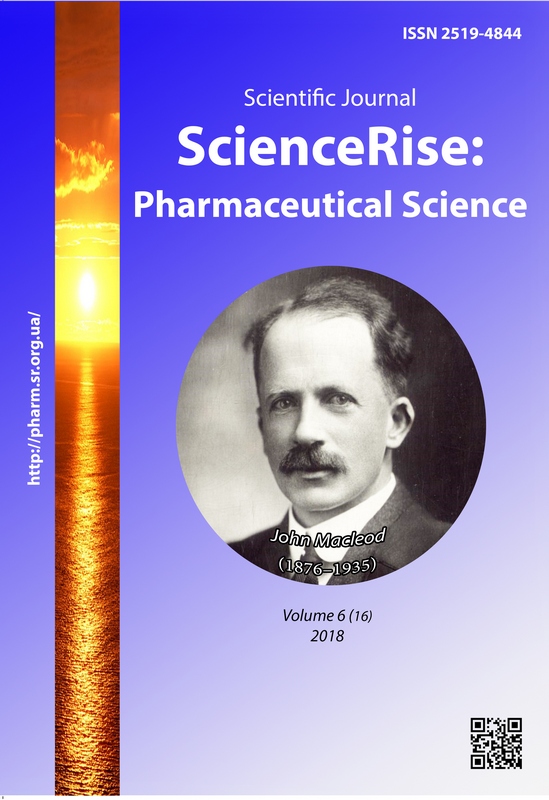Дослідження з розробки складу комбінованого гелю для лікування запальних захворювань суглобів
DOI:
https://doi.org/10.15587/2519-4852.2018.151447Ключові слова:
комбінований гель, склад, консерванти, антимікробна активність, ніпагін, технологія, запалення суглобівАнотація
Мета: метою нашої роботи було експериментальне обґрунтування ефективності антимікробних консервантів у розробці складу комбінованого гелю, призначеного для лікування гострого та хронічного запалення суглобів.
Методи: застосовувався біологічний фармакопейний метод дослідження (дослідження ефективності антимікробних консервантів).
Результати. Усі лікарські препарати мають відповідати вимогам нормативних документів за показником «Мікробіологічна чистота». Для забезпечення мікробіологічної стабільності препаратів, необхідним є максимальне усунення факторів, пов'язаних із мікробною контамінацією, тому нами було проведено експериментальні дослідження з вибору консерванта та його концентрації для гелю, що розробляється. За результатами проведених експериментальних досліджень із вивчення ефективності антимікробних консервантів у зразках гелів було отримано такі дані. Зразки досліджуваного гелю з консервантами натрію бензоатом 0,5 % та ніпагіном 0,2 % відповідають критерію «А» за вимогами ДФУ для лікарських препаратів для нашкірного використання. Однак, за результатами досліджень, антимікробна ефективність гелю з консервантом ніпагін 0,2 % була дещо вищою (lg зменшення кількості життєздатних клітин Staphylococcus aureus АТСС 6538 дорівнювала 3,32 та 4,81; Pseudomonas aeruginosa АТСС 9027 – 3,28 та 4,66; Candida albicans АТСС 885-653 – 3,50 та 4,09; Aspergillus brasiliensis АТСС 16404 – 3,10 та 4,00) (на 2 та 7 добу відповідно) і спектр антимікробної дії більш широкий, що сприятиме якості розробленого гелю і у процесі його зберігання. Тому для подальших досліджень нами буде використовуватись у якості консерванту ніпагін 0,2 %.
Висновки: теоретично обґрунтовано та експериментально доведено доцільність використання у складі комбінованого гелю для терапії гострого та хронічного запалення суглобів консерванту ніпагін 0,2 %
Посилання
- Akao, T., Yoshino, T., Kobashi, K., Hattori, M. (2002). Evaluation of Salicin as an Antipyretic Prodrug that does not Cause Gastric Injury. Planta Medica, 68 (8), 714–718. doi: http://doi.org/10.1055/s-2002-33792
- Bisset, N. G. (2004). Herbal Drugs and Phytopharmaceuticals. Stuttgart: Medpharm Scientific Publishers, 534–536.
- Meier, F. M., Frerix, M., Hermann, W., Müller-Ladner, U. (2013). Current immunotherapy in rheumatoid arthritis. Immunotherapy, 5 (9), 955–974. doi: http://doi.org/10.2217/imt.13.94
- Klimes, J., Vocelka, M., Sedova, L., Dolezal, T., Mlcoch, T., Petrikova, A., Vlcek, J. (2014). Medical and Productivity Costs of Rheumatoid Arthritis in The Czech Republic: Cost-of-Illness Study Based on Disease Severity. Value in Health Regional Issues, 4, 75–81. doi: http://doi.org/10.1016/j.vhri.2014.07.004
- Postoi, V. V., Vyshnevska, L. I. (2017). Doslidzhennia z rozrobky skladu heliu dlia likuvannia revmatoidnoho artrytu. Kyiv, 2, 143.
- Postoi, V. V., Vyshnevska, L. I. (2018). The marketing research of the Ukrainian market of drugs for the treatment of arthritis. News of Pharmacy, 1 (93), 38–42. doi: http://doi.org/10.24959/nphj.18.2198
- Derzhavna Farmakopeia Ukrainy (2011). Kharkiv: Derzhavne pidpryiemstvo «Naukovo-ekspertnyi farmakopeinyi tsentr», RIREH, 536.
- Derzhavna Farmakopeia Ukrainy Kharkiv. Vol. 1 (2015). Kharkiv: Derzhavne pidpryiemstvo «Ukrainskyi naukovyi farmakopeinyi tsentr yakosti likarskykh zasobiv», 1128.
- Mirsonbol, S. Z., Issazadeh, K., Pahlaviani, M., Momeni, N. (2014). Antimicrobial efficacy of the methylparaben and benzoate sodium against selected standard microorganisms, clinical and environmental isolates in vitro. Indian Jornal of Fundamental and Applied Life Sciences, 4 (S4), 363–367.
- Stanojevic, D. C. (2009). Antimicrobial effects of Sodium benzoate, Soium nitrate and Potassium sorbate and Their synergistic action in vitro. Bulgarian Journal of Agricultural Science, 15 (4), 307–311.
##submission.downloads##
Опубліковано
Як цитувати
Номер
Розділ
Ліцензія
Авторське право (c) 2018 Liliia Vyshnevska, Oksana Strilets, Postoy Vladyslav

Ця робота ліцензується відповідно до Creative Commons Attribution 4.0 International License.
Наше видання використовує положення про авторські права Creative Commons CC BY для журналів відкритого доступу.









